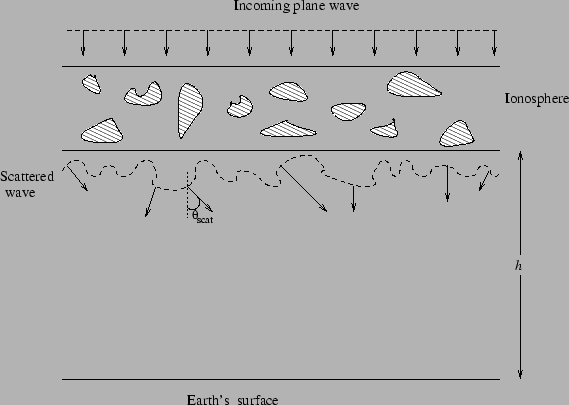 |
In the last section we dealt with an ionosphere which had random density fluctuations in it. In the model we assumed the density was assumed to vary randomly with position, but not with time. In the earth's ionosphere however, the density does vary with both position and time. Temporal variations arise both because of intrinsic variation as well as because of traveling disturbances in the ionosphere, because of which a given pattern of density fluctuations could travel across the line of sight.
This temporal variation of the density fluctuations means that the coherence function (even at some fixed separation on the surface of the earth) will vary with time. This phenomena is generically referred to as ``scintillation''. Depending on the typical scattering angle as well as the typical height of the scattering layer from the surface of the earth, the scintillation could be either ``weak'' or ``strong''.
As discussed in the previous section, rays on passing
through an irregular ionosphere get scattered by a typical angle
![]() . If the scattering occurs at a height
. If the scattering occurs at a height ![]() above
the antennas, then as shown in Figure 16.5 these
scattered rays have to traverse a further distance
above
the antennas, then as shown in Figure 16.5 these
scattered rays have to traverse a further distance ![]() before
being detected. The transverse distance traveled by a scattered
ray is
before
being detected. The transverse distance traveled by a scattered
ray is
![]() . If this length is much less than
the coherence length
. If this length is much less than
the coherence length ![]() , then the rays scattered by different
irregularities in the scattering medium do not intersect before
reaching the ground. The corresponding condition is that
, then the rays scattered by different
irregularities in the scattering medium do not intersect before
reaching the ground. The corresponding condition is that
![]() , i.e.
, i.e.
![]() or
or
![]() .
.
If this condition holds, then, at any instant of time,
(as discussed in the previous section), what the observer sees is
an undistorted image of the source, which is shifted in position
due to refraction. As time passes, the density fluctuations
change16.3 and so the image appears to wander in the sky and
in a long exposure image which averages many such wanderings,
the source appears to have a scattered broadened size ![]() .
Provided that one can do self calibration on a time scale
that is small compared to the time scale of the ``image wander'',
this effect can be corrected for completely. On the other hand,
when the
.
Provided that one can do self calibration on a time scale
that is small compared to the time scale of the ``image wander'',
this effect can be corrected for completely. On the other hand,
when the
![]() the rays from different
density fluctuations will intersect and interfere with one
another. The observer sees more than one image, and because
of the interference, the amplitude of the received signal
fluctuates with time. This is called ``amplitude'' scintillation.
Amplitude scintillation at low frequencies, particularly over
the Indian subcontinent can be quite strong. The source flux
could change be factors of 2 or more on very short timescales.
This effect cannot be reliably modeled and removed from the
data, and hence observations are effectively precluded during
periods of strong amplitude scintillation.
the rays from different
density fluctuations will intersect and interfere with one
another. The observer sees more than one image, and because
of the interference, the amplitude of the received signal
fluctuates with time. This is called ``amplitude'' scintillation.
Amplitude scintillation at low frequencies, particularly over
the Indian subcontinent can be quite strong. The source flux
could change be factors of 2 or more on very short timescales.
This effect cannot be reliably modeled and removed from the
data, and hence observations are effectively precluded during
periods of strong amplitude scintillation.